Travel
An epic road trip over and under the Atlantic Ocean
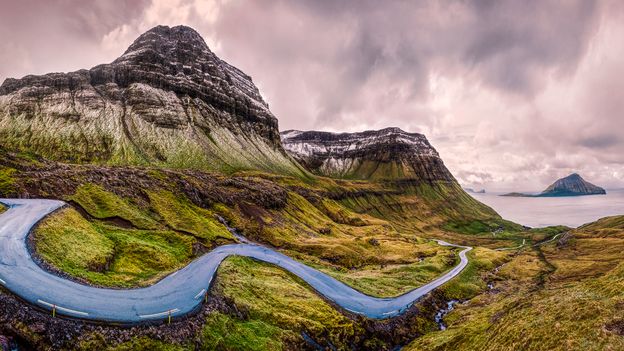
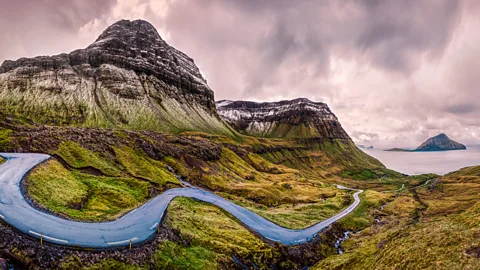
With tourism set to reach an all-time high in the Faroe Islands this year, travellers should seek out the archipelago’s slower roads and newly opened sub-sea tunnels.
Only minutes out of Sørvágur village on the island of Vágar in the Faroe Islands, the road crept towards a sheer verge above the ocean and I passed a signpost fixed with a distinctive sign. It wasn’t marked with any numbers or words, just the image of a bright-yellow flower on a green background. Ahead, the road zig-zagged, climbing past sod-roofed houses and a field of fidgety sheep, then vanished abruptly from sight through a dark mountain tunnel.
Road signs usually warn users about speed limits, hazards or the presence of livestock or wildlife. So it took me a moment or two to work out its meaning. The yellow flower on the sign is a marsh marigold from the buttercup family and it is the national flower of the Faroe Islands. With some of the strongest winds in Europe, no trees grow on the archipelago, so it is often this glossy buttercup, called sóljuleiðir in Faroese, that colours the grasses, ridges and clifftops.
That day, however, the flower also was a siren call. The signs on which it appeared were an invitation to drive away from the main highways, tempting me and other visitors to the lesser-travelled – and most beautiful – roads in the Faroe Islands. These “Buttercup Routes” are not just about getting somewhere quickly or on time. Rather, the vibe, excitingly, is Driving Miss Daisy meets the wild drama of Lord of the Rings’ Middle-earth.
A map of the Faroes created by Landsverk, the country’s Ministry of Transport, shows 13 of these routes across the pinprick-sized 18 islands, with each itinerary resembling a yellow brick road of opportunity. And, as the country continues to receive more tourists year on year – currently around 100,000 annually, double the Faroes’ population – the idea is to prevent traffic congestion, but also to bring road-trippers closer to the rare stillness that sums up life on the edge in the North Atlantic Ocean.
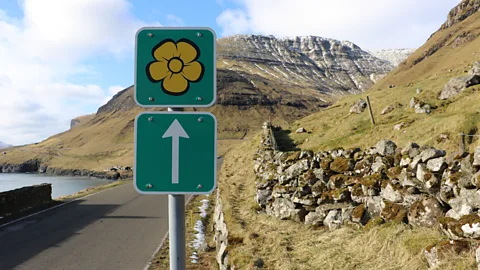 Mike MacEacheran
Mike MacEacheranI spent five days in the country driving eight of the Soljuleiðir routes – and saw that, with a bit of careful navigation, it is indeed always a better idea to take the long way round.
The first Buttercup Route, Gásadalsleið, took me through that dark mountain tunnel to Múlafossur waterfall, which cascades into the sea beside the village of Gásadalur. From the precipice overlooking the falls, a short walk from where I parked my car, I could see the surging channel leading to Mykines, the Faroes’ westernmost island. Shadowed by a long scarf of fog, the whole scene was wildly beautiful.
Gásadalsleið is short in road trip terms – a 15-minute drive at most – but it encapsulates all that is wildly terrific about the Faroe Islands: sea panoramas, the molar-shaped crests of mountains, gossamer waterfalls and roads that seem to miraculously cling to cliffsides.
In fact, the 13 driving itineraries, which cover nearly the entire country, are ceaseless in their pursuit of arriving abruptly at poetic destinations. Of varying length (around 3.8km to 19.5km), they prise the lid on ocean-drop waterfalls, hanging lakes and silent valleys where sheep with wind-blown rock-star hairdos vastly outnumber people.
One itinerary – named Saksunarleið – leads to the village of Saksun on Streymoy island, stopping short of the sea at a turf-roofed church and inlet where the water sucks and wheezes between two sheer cliff faces. Another, on the island of Eysturoy, switchbacks above Funningsfjørður, a fjord hemmed in by a huddle of summits, before rolling down to the harbour village of Gjógv. Once parked, this is where I stood with a sublime view of the island Kalsoy across the channel, whose dragon-scale ridges made it look like a leviathan lifting its body out of the deep. It is the sort of unexpected viewpoint you dream of finding on a road trip, but so rarely do.
 Getty Images
Getty ImagesIndeed, the art of the road trip has been seriously elevated in the Faroe Islands recently, and not just with the introduction of the scenic Buttercup Routes. In December 2023, a new 10.8km sub-sea tunnel opened, connecting the islands of Streymoy and Sandoy – previously a 30-minute ferry ride apart. Bringing the number of sub-sea tunnels in the Faroe Islands to four, Sandoyartunnilin opens up better access to the Buttercup Routes, shortens circuitous entry and exit points and heightens the all-round sense of road trip satisfaction.
At a depth of more than 150m below the seabed, the new Sandoyartunnilin is no ordinary subsea tunnel. For starters, it features a folkloric art installation in red, blue and white neon that runs along the bedrock of the tunnel walls. The brushstroke-style illuminated pictographs show Catholic knights in armour, representative of the ruined church of Kirkjubøur at the tunnel’s northern entrance, as well as silhouettes of shepherds, fishermen, seals, cattle and birds created by Faorese artist Edward Fuglø. These totems of the past are accompanied by an ethereal soundtrack composed by Faroese composer Sunleif Rasmussen. To listen to this ghostly recording, I simply had to tune my car radio to 100 FM.
The idea, according to the tunnel’s CEO Teitur Samuelsen, is to celebrate Faroese folklore while also turning the journey into something entirely unexpected for visitors. “The first known painter in the Faroe Islands, Díðrikur á Skarvanesi, came from Sandoy in the 19th Century and it was always our idea to connect his origin story to the tunnel,” he told me. “He painted moon pigeons, so the pictures of the birds and the other symbols break up the monotony of this long subsea tunnel.” More than that, he said, the feeling is to evoke a sense of ceremony and national memory, less of simply motoring somewhere under the Atlantic Ocean in the dark.
Helga Hilmarsdóttir, a local who lives on Sandoy with her husband and children, summed this up when I met her later that day in the village of Dalur. “The tunnel has given everyone new purpose and is helping create new life in villages like ours – people don’t want to spend all their lives milking cows or herding sheep anymore,” she said.
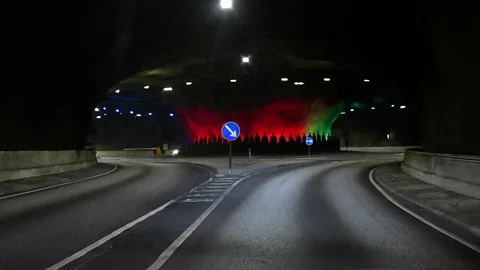 Getty Images
Getty ImagesEarly next year, her family will open seven new rooms for rent on the hillside behind their house – the first tourist accommodation in the village. Already, they have opened their home to tourists as part of the country’s “heimablídni” concept, an informal supper club experience where visitors can enjoy traditional Faroese meals in people’s homes.
“We know tourists are coming to the Faroe Islands,” said Hilmarsdóttir, “so, this provides an opportunity to connect with them better so they can learn from us and our traditions.”
Another important stop on a visitor’s journey is Eysturoyartunnilin, the sister tunnel to Sandoyartunnilin that opened under Tangafjørður Sound in December 2020. Connecting Streymoy to neighbouring Eysturoy, the 11.24km, three-branch subsea tunnel is currently home to the only roundabout under the Atlantic and it is so abstract that to drive through it feels like entering a portal to an alien world.
“We felt this could be our Big Ben or Eiffel Tower – a tourist attraction in its own right,” Samuelsen told me, recalling the project’s starting point. “So, the art installation created on the roundabout by Faroese artist Tróndur Patursson is now at the geographic centre of the country, and the steel figures holding hands are looking inwards, but up to the light.”
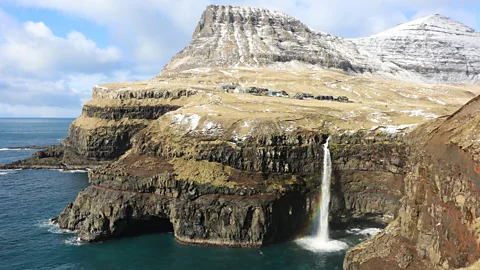 Mike MacEacheran
Mike MacEacheranOnce a place where insularity was almost part of the identity, the message is the Faroes are gently evolving, but only on the terms set by its people.
There was time for one last road to follow, and it took me out of Tórshavn, onto Oyggjarvegur, the name given to the Buttercup Route climbing into the mountains above the capital. It was immeasurably more panoramic than the faster road along the coast and the high point was the view from Norðadalsskar across to the dorsal fin shaped island of Koltur. Below, the tide was at full tilt, the land glimmering silver in the sun, and at no point did I see another vehicle on the road.
Surely, there’s a moral in there somewhere.
The Open Road is a celebration of the world’s most remarkable highways and byways, and a reminder that some of the greatest travel adventures happen via wheels.



)






